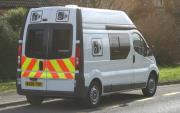This is an interesting one in the Telegraph.

Some people are clever, and some people just think they are. Dr Tennore Ramesh appears to be a member of the latter category.
He was picked up doing 41mph in a 30mph zone by one of those mobile speed traps in Sheffield. He denied the charge, and tried to use Google Earth distances to prove that he wasn’t breaking the limit.
I’m not quite sure what he was thinking, since in order to identify someone’s speed you need to be able to measure distances very accurately, and Google Earth images consist of stitched frames. So although they are fine for measuring distances of many miles, where a mile or so either way isn’t significant, when it comes to the definition needed to prove speed to this level… well, it’s clutching at straws right from the start.
At best, you could perhaps argue the toss on an average speed over a long distance – but a precise speed at a specific point? I don’t think so.
But an expert for the prosecution proved that Google Earth distances are inaccurate.
More telling, Ramesh already had 3 points on his licence for… you guessed it: speeding. And he had held his UK licence for less than two years, which means that if he got 6 points then he would be banned and forced to take his test again.
When the prosecution evidence became known, Ramesh had to change his not guilty plea to guilty on the morning of the trial. He therefore urged the court to ban him outright so that he didn’t get the extra 3 points in the belief it would save him from the need to retake his test.
Fortunately, we have another judge (that makes two by my reckoning) who still maintains links with reality. Naomi Redhouse refused to impose a ban on its own just because it would be to his advantage. She slapped him with 3 points and left the decision over his licence with the DVLA.
Ramesh was ordered to pay nearly £4,000 costs and was fined nearly £400. Plus – if the DVLA does the right thing – he’ll end up paying a few hundred more for lessons and tests.